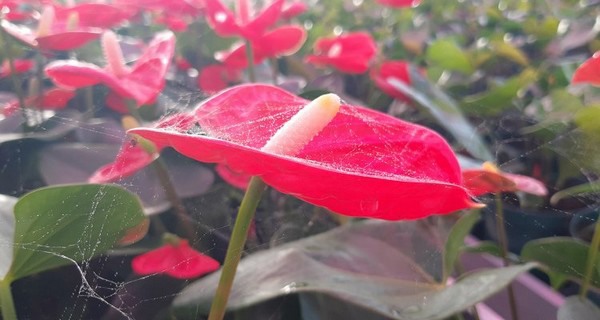Several crops are grown in the demonstration Greenhouse 2030 with the support of the program 'Kas als Energiebron' (Greenhouse as Source of Energy). The goal is emission-free cultivation: free of CO2 emission from fossil fuels (a fully electric greenhouse), free of water and fertilizer emissions, and free of emissions from plant protection products.
That is, just as in the commercial cultivation system, rather challenging. Pot Anthurium growers must control several thrips species, including the newcomer Thrips parvispinus (tobacco thrips). While the growers are experienced in dealing with the Western flower thrips, the Echinothrips, and the anthurium thrips, the tobacco thrips disrupted the entire system, resulting in higher plant protection product use in the first half of 2021. In Greenhouse2030, we also had to apply corrective products several times during that period.

With an 'out-of-the-box' idea, we introduced a minuscule Linyphiidae spider. The spiders have nested in various places in the plants, their very fine webs were also present in the flowers, between the spadix and the spathe. The webs are so fine that they only become visible after wetting them with a fine mist. These spiders quickly colonized the entire greenhouse feeding themselves with the fungus gnats and various flies that are always present in the greenhouses. In order to maintain this food source for the spiders, we have completely stopped adding nematodes to the substrate to control the fungus gnat population.
This strategy with the spiders, supplemented with predatory mites (A. swirskii or T. montdorensis) and with larvae of the green lacewing Chrysoperla carnea, resulted in very good control of the Thrips: no full field corrections have been necessary during the whole of last year (only one(local) correction with plant protection products against was applied to one variety especially sensitive to tobacco thrips). In this demonstration setup, it is difficult to draw firm conclusions about the specific role of each of the three biological control agents, but the results of this strategy are promising.
In a separate study, different biological control agents and strategies for the control of tobacco thrips and other exotic thrips species are being investigated.
Source: wur.nl
